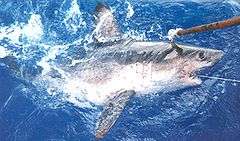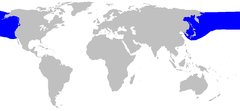Salmon shark
| Salmon shark | |
|---|---|
 | |
| Scientific classification | |
| Kingdom: | Animalia |
| Phylum: | Chordata |
| Class: | Chondrichthyes |
| Subclass: | Elasmobranchii |
| Superorder: | Selachimorpha |
| Order: | Lamniformes |
| Family: | Lamnidae |
| Genus: | Lamna |
| Species: | L. ditropis |
| Binomial name | |
| Lamna ditropis C. L. Hubbs & Follett, 1947 | |
 | |
| Range of the salmon shark | |
The salmon shark (Lamna ditropis) is a species of mackerel shark found in the northern Pacific ocean. As an apex predator, the salmon shark feeds on salmon, squid, sablefish, and herring.[2] Salmon sharks are known for their ability to maintain stomach temperature (homeothermy),[3] which is unusual among fish. The salmon shark has not been demonstrated to maintain a constant body temperature. The salmon shark is also known for an unexplained variability in the sex ratio between eastern and western populations in the northern Pacific.[4]
Biology
Adult salmon sharks are medium grey to black over most of the body, with a white underside with darker blotches. Juveniles are similar in appearance, but generally lack blotches. The snout is short and cone-shaped, and the overall appearance is similar to a small great white shark. The eyes are positioned well forward, enabling binocular vision to accurately locate prey.
Salmon sharks generally grow to between 200 and 260 cm (6.6–8.6 ft) in length and weigh up to 220 kg (485 lb).[5] Males appear to reach a maximum size slightly smaller than females. Unconfirmed reports exist of salmon sharks reaching as much as 4.3 m (14.2 ft); however, the largest confirmed reports indicate a maximum total length of about 3.0 m (10 ft).[4] The maximum reported weight of this heavily built shark is over 450 kg (992 lb).[6]
Reproduction
Salmon sharks are ovoviviparous, with a litter size of two to six pups.[7] As with other Lamniformes shark species, salmon sharks are oophagous, with embryos feeding on the ova produced by the mother.
Females reach sexual maturity at eight to ten years, while males generally mature by age five.[8] Reproduction timing is not well understood, but is believed to be on a two-year cycle with mating occurring in the late summer or early fall.[4] Gestation is around nine months. Some reports indicate the sex ratio at birth may be 2.2 males per female, but the prevalence of this is not known.[4]
Homeothermy
As with only a few other species of fish, salmon sharks have the ability to regulate their body temperature.[3] This is accomplished by vascular counter-current heat exchangers, known as retia mirabilia, Latin for "wonderful nets". Arteries and veins are in extremely close proximity to each other, resulting in heat exchange. Cold blood coming from the gills to the body is warmed by blood coming from the body. This results in blood coming from the body losing their heat so that by the time they interact with cold water from the gills, they're approximately the same temperature so no heat is lost from the body to the water. Whereas blood coming towards the body regain their heat, allowing the shark to maintain its body temperature. This minimizes heat lost to the environment, allowing salmon sharks to thrive in cold waters.
Their homeothermy may also rely on SERCA2 and Ryanodine receptor 2 protein expression, which may have a cardioprotective effect.[9]
Range and distribution
It is common in continental offshore waters, but ranges inshore to just off beaches. They occur singly, in feeding aggregations of several individuals or in schools. Tagging has revealed a range which includes sub-Arctic to sub-tropical waters.[9]
Salmon sharks occur in the northern Pacific Ocean, in both coastal waters and open ocean. They are believed to range as far south as the Sea of Japan and as far north as 65°N in Alaska and in particular in Prince William Sound during the annual salmon run. Individuals have been observed diving as deep as 668 m,[10] but they are believed to spend most of their time in epipelagic waters.
Regional differences
Age and sex composition differences have been observed between populations in the eastern and western North Pacific. Eastern populations are dominated by females, while the western populations are predominantly male.[5] It is not known if these distinctions stem from genetically distinct stocks, or if the segregation occurs as part of their growth and development. It has been widely speculated that the difference between population differences may be a result of the Japanese fishermen harvesting the male population. Japanese herbalists will use the fins of male Salmon sharks as ingredients in many traditional medicines said to treat various forms of cancer.[11]
Human interactions
Currently, no commercial fishery for salmon shark exists, but they are occasionally caught as bycatch in commercial salmon gillnet fisheries, where they are usually discarded. Commercial fisheries regard salmon sharks as nuisances since they can damage fishing gear[7] and consume portions of the commercial catch. Fishermen deliberately injuring salmon sharks have been reported.[12]
Sport fishermen fish for salmon sharks in Alaska.[13] Alaskan fishing regulations limit the catch of salmon sharks to two per person per year. Sport fishermen are allowed one salmon shark per day from April 1 to March 31 in British Columbia.[14]
The flesh of the fish is used for human consumption, and in the Japanese city of Kesennuma, Miyagi, the heart is considered a delicacy for use in sashimi.[7]
Although salmon sharks are thought to be capable of injuring humans, few, if any, attacks on humans have been reported, but reports of divers encountering salmon sharks and salmon sharks bumping fishing vessels have been given.[12] These reports, however, may need positive identification of the shark species involved.[7]
See also
References
- ↑ Goldman, Kenneth; Kohin, Suzanne; Cailliet, Gregor M. & Musick, John A. (2009). "Lamna ditropis". IUCN Red List of Threatened Species. Version 3.1 (3.1). International Union for Conservation of Nature. Retrieved 11 April 2012.
- ↑ Hulbert, Leland B.; Rice, J. Stanley (December 2002). "Salmon Shark, Lamna ditropis, Movements, Diet and Abundance in the Eastern North Pacific Ocean and Prince William Sound, Alaska". Exxon Valdez Oil Spill Restoration Project 02396.
- 1 2 Goldman, Kenneth; Anderson, Scot; Latour, Robert; Musick, John A. (2004). "Homeothermy in adult salmon sharks, Lamna ditropis". Environmental Biology of Fishes. 71 (4): 403–411. doi:10.1007/s10641-004-6588-9.
- 1 2 3 4 Goldman, Kenneth (August 2002). "Aspects of Age, Growth, Demographics, and Thermal Biology of Two Lamniform Shark Species". PhD Dissertation, College of William and Mary, School of Marine Science.
- 1 2 Goldman, Kenneth; Musick, John A. (2006). "Growth and maturity of salmon sharks (Lamna ditropis) in the eastern and western North Pacific, and comments on back-calculation methods". Fishery Bulletin. 104 (2): 278–292.
- ↑ http://www.flmnh.ufl.edu/fish/Gallery/Descript/salmonshark/salmonshark.html
- 1 2 3 4 Compagno, Leonard (2001). Sharks of the World, Vol. 2. Rome, Italy: FAO.
- ↑ Nagasawa, Kazuya (1998). "Predation by Salmon Sharks (Lamna distropis) on Pacific Salmon (Oncorhynchus spp.) in the North Pacific Ocean". Bulletin of the North Pacific Anadromous Fish Commission. 1: 419–432.
- 1 2 Weng, Kevin C.; Pedro C. Castilho; Jeffery M. Morrissette; Ana M. Landeira-Fernandez; David B. Holts; Robert J. Schallert; Kenneth J. Goldman; Barbara A. Block (2005). "Satellite Tagging and Cardiac Physiology Reveal Niche Expansion in Salmon Sharks" (PDF). Science. 310: 104–106. doi:10.1126/science.1114616.
- ↑ Hulbert, Leland B.; Aires-da-Silva, Alexandre M.; Gallucci, Vincent F.; Rice, J. Stanley (2005). "Seasonal foarging movements and migratory patterns of female Lamna ditropis tagged in Prince William Sound, Alaska". Journal of Fish Biology. 67 (2): 490–509. doi:10.1111/j.0022-1112.2005.00757.x.
- ↑ http://edition.cnn.com/2009/HEALTH/06/24/traditional.treatment/index.html?iref=24hours
- 1 2 "Biology of the Salmon Shark". Reefquest Center for Shark Research. Retrieved 2006-09-14.
- ↑ "Fishing for Salmon Shark in Alaska". Fish Alaska Magazine. Retrieved 2006-09-14.
- ↑ http://www.pac.dfo-mpo.gc.ca/fm-gp/rec/species-especes/fintable-tableaupoisson-eng.html
External links
| Wikispecies has information related to: Lamna ditropis |
- Froese, Rainer and Pauly, Daniel, eds. (2006). "Lamna ditropis" in FishBase. May 2006 version.
- Salmon shark fact sheet
- Florida Museum of Natural History, information about salmon sharks
- TOPP, Tagging of Pacific Predators, a research group that tags salmon sharks to learn more about their habits.
- IMDB entry for Icy Killers, a wild-life documentary about salmon sharks.
